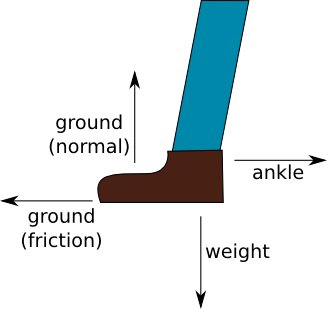Why you slip on ice (and how to avoid it)
Posted by David Zaslavsky on — CommentsEarlier this week I stepped on what must be the closest thing on Earth to a frictionless surface.

No, not a physics experiment, but an afternoon’s worth of freezing drizzle. The roads and sidewalks are coated with an unusually smooth layer of ice, making it hard to walk anywhere without risking a pretty spectacular fall. Of course, despite the entertainment value, slipping on ice is inconvenient and potentially dangerous and most of us try pretty hard to avoid it. Luckily, physics can help.
Take a moment to think about how exactly people walk. Here’s a (slightly unrealistic) diagram of a walking person’s foot:

There are four forces that act on this foot. In the vertical direction, you have the person’s weight pushing down and the normal force from the ground pushing up. In the horizontal direction, you have a force from your ankle pushing backwards (think about it: you actually push backwards on your feet when you walk), and the force of friction against the ground pushing forwards. Your foot feels no net force and stays still, but if you consider your body as a whole, there’s nothing to counteract that friction. Now, according to Newton’s second law, a net force causes acceleration, so if you want to slow down, speed up, or change direction (which all qualify as accelerating), friction is what does it for you.
When you’re on an icy sidewalk, though, you basically don’t have any friction. Based on the analysis so far, that suggests that you won’t be able to slow down, speed up, or change direction while on ice — which is definitely true. If you try to turn a corner while walking over an ice patch, you’re setting yourself up to fall down.
It might occur to you that nothing stops you from walking over ice at a steady speed in a constant direction, since you don’t need friction if you’re not accelerating. In fact, you can do that, but it doesn’t just happen by accident. The motion of walking is really like falling forward and using your foot to stop you, which means that when your foot normally hits the ground, it’s already moving forward. When you have sufficient friction, it’s able to slow the foot down to a stop almost immediately, allowing you to put your weight on it, but on an icy surface, the friction doesn’t kick in, and your foot slips out from under you.
So what does this mean? Well, since slipping results from a lack of friction, obviously the best way to avoid slipping is to walk on rough surfaces. Dry roads and sidewalks are best, but if you can’t do that, even walking on snow is better than walking on ice. If you do have to cross an ice patch, make sure to put your feet straight down, kind of like marching, and avoid turning or changing speed until you’re back on rough ground.
In an upcoming post, I’ll examine whether and how this changes when you’re on a hill.